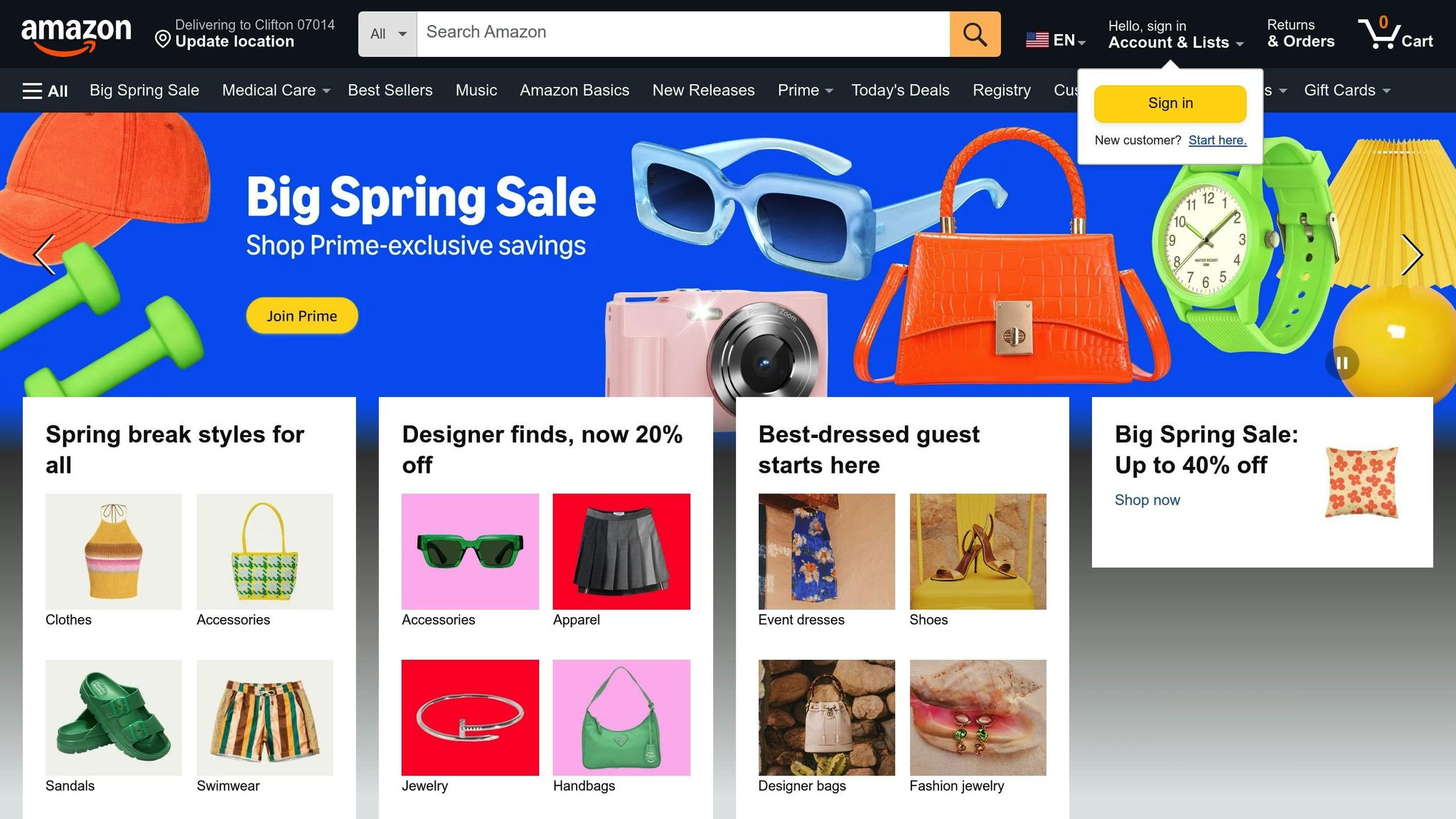
- Harsh Maur
- March 27, 2025
- 7 Mins read
- WebScraping
Benefits of Amazon Web Scraping for E-commerce Websites
Amazon web scraping can help e-commerce businesses gather valuable data to improve pricing, track competitors, and analyze customer feedback. Here's a quick overview of its key benefits:
- Price Tracking: Monitor real-time price changes, seasonal trends, and competitor strategies to stay competitive.
- Market Research: Identify trending products, seasonal patterns, and growing market segments.
- Customer Insights: Analyze reviews to improve products and understand customer preferences.
- Sales Performance: Track sales rankings, seasonal fluctuations, and market share.
- Seller Data: Evaluate seller performance, fulfillment methods, and product catalogs.
Amazon Web Scraping Benefits

Market data shows that price is the most important factor for online shoppers. For e-commerce businesses, understanding price trends is key to staying competitive.
Price Tracking
Keeping track of prices depends on collecting and analyzing data consistently. Since over 86% of consumers compare prices across platforms, businesses need to stay competitive without sacrificing profitability. Web scraping helps by allowing businesses to:
- Monitor price changes in real time and spot seasonal trends
- Adjust prices quickly to stay competitive
- Keep an eye on competitor pricing strategies
- Fine-tune pricing during sales events
Market Research
Amazon's vast marketplace offers a treasure trove of data that can guide business decisions.
This data allows businesses to focus on:
| Research Focus | Business Impact |
|---|---|
| Trending Products | Spot high-demand items for better inventory |
| Seasonal Patterns | Predict demand changes |
| Category Performance | Find growing market segments |
| Competitive Analysis | Gain insights on market positioning |
Using these insights, businesses can sharpen their strategies and strengthen their market presence.
Market Position Analysis
To understand their place in the market, businesses need detailed competitor insights. Web scraping makes it possible to gather data on:
- Product positioning
- Market share trends
- Competitive strengths
- Sales performance
Customer Feedback Analysis
Scraping customer reviews provides key insights for improving products. By analyzing this feedback, businesses can:
- Identify product issues and understand customer preferences
- Track customer sentiment over time
- Improve product descriptions and features based on feedback
Key Amazon Data Points
To get the most out of Amazon web scraping, it’s important to know which data points to focus on. Amazon's massive marketplace generates a wealth of information that can guide smarter e-commerce decisions.
Product Information
The foundation of competitive analysis lies in core product details. Key data points include:
| Data Element | Business Value |
|---|---|
| Base Price | Understand market positioning |
| Sale Price | Track promotional strategies |
| Stock Status | Spot supply trends |
| Product Specifications | Compare features across products |
| Category Classification | Pinpoint market segments |
By tracking thousands of products, you can uncover market gaps and opportunities. Considering Amazon processes over 66,000 orders per hour, even small pricing adjustments can make a big difference in sales. These details are essential for grasping broader sales trends.
Sales Performance Data
Sales rankings provide key insights into market performance. Important metrics to monitor include:
- Best Sellers Rank (BSR) changes over time
- Trends in category performance
- Seasonal sales fluctuations
- Distribution of market share
Given Amazon’s 41% share of U.S. e-commerce retail sales, understanding these metrics can help predict market shifts and adjust inventory strategies effectively.
Review Data
Customer reviews add another layer of insight. Here are the critical elements to analyze:
| Review Component | Focus Area |
|---|---|
| Star Ratings | Gauge overall satisfaction |
| Written Feedback | Identify specific issues |
| Review Volume | Measure market engagement |
| Q&A Data | Highlight common concerns |
These insights go beyond sales numbers, helping businesses fine-tune their offerings based on customer feedback.
Seller Data
Seller performance metrics uncover potential market opportunities. Key data points to track include:
- Fulfillment methods (e.g., FBA or self-fulfillment)
- Seller ratings and customer feedback
- Size of product catalogs
- Length of time in the marketplace
With Amazon shipping around 1.6 million packages daily, monitoring seller data can identify successful strategies and reveal gaps in the market. This is especially useful for spotting unauthorized sellers or counterfeit products.
sbb-itb-65bdb53
Data Collection Best Practices
Scraping data from Amazon effectively requires a focus on legal compliance, technical execution, and maintaining high data quality. Sticking to these practices ensures reliable results while staying within ethical boundaries.
Legal Compliance
Collecting data responsibly from Amazon means sticking to clear rules. Focus only on publicly available information and respect the platform's restrictions. Here's a breakdown of key areas, recommended practices, and ways to reduce risks:
| Compliance Area | Best Practice | Risk Mitigation |
|---|---|---|
| Data Access | Stick to public product data | Avoid accessing login-protected content |
| Server Load | Use request throttling | Prevent IP blocks or bans |
| Privacy | Exclude personal information | Protect user data |
| Usage Rights | Limit to fair use cases like market research | Avoid misuse of data |
To reduce strain on Amazon's servers, control the rate of your requests and avoid scraping restricted pages. This disciplined approach helps you stay within Amazon's policies. At the same time, using the right technical tools ensures smooth data collection without interruptions.
Technical Solutions
Once compliance is handled, the next step is implementing effective technical strategies to ensure smooth and efficient data collection. Modern tools and methods help you tackle common challenges. Here’s what to focus on:
Request Management
- Add delays between requests to avoid being rate-limited.
- Use rotating proxies and CAPTCHA-solving tools to maintain access.
- Spread traffic across multiple endpoints to prevent detection.
Data Structure
- Save data in formats like JSON or CSV for easier analysis.
- Stick to consistent data schemas for seamless integration.
- Handle pagination properly to ensure complete data collection.
Depending on your needs, tools for Amazon scraping range from free basic options to premium services costing about $500 per month, often with trial periods included.
Data Quality Control
Even with strong technical methods, maintaining high-quality data is critical for making informed decisions. Use these steps to keep your data clean and reliable:
Validation Protocols
- Cross-check data points by reloading pages.
- Automate error detection during the scraping process.
- Ensure data is consistently formatted for easier use.
Monitoring Systems
- Track the success rate of your scraping operations.
- Check for gaps to ensure complete datasets.
- Log and resolve validation errors as they occur.
As Amazon frequently updates its website, regularly adjusting your scraper logic is necessary. Double-checking data through thorough quality assurance helps catch and fix any issues before they affect your analysis.
Using Amazon Data
With reliable data in hand, businesses can tap into Amazon's insights to make smarter decisions.
Price Strategy
Amazon's dynamic pricing system updates prices more than 2.5 million times daily, generating a constant stream of useful data. This isn't just about tracking prices - it’s about identifying the best price points to stay competitive while maintaining profitability. By analyzing this data, businesses can refine their pricing strategies, potentially boosting annual profits by 25%.
| Price Analysis Component | Action Items | Expected Outcome |
|---|---|---|
| Competitive Monitoring | Track daily price changes | Understand market position |
| Historical Trends | Study seasonal patterns | Time price adjustments effectively |
| Customer Behavior | Analyze purchase habits | Set optimal price limits |
| Market Dynamics | Monitor inventory levels | Adjust prices based on supply and demand |
Pricing adjustments are just one piece of the puzzle. Amazon data can also guide product improvements.
Product Development
Customer reviews and Q&A sections on Amazon hold valuable insights. By analyzing this feedback using text analytics, businesses can pinpoint common complaints and identify features customers love. This allows companies to make precise updates to their products, ensuring they better align with customer expectations.
But the benefits of Amazon data don’t stop there. It’s also a goldmine for refining marketing strategies.
Marketing Improvements
Amazon’s marketplace, with its massive user base of roughly 310 million active customers, offers a wealth of information for sharpening marketing efforts. By examining product listings, businesses can improve SEO, find trending keywords, and identify seasonal buying trends. Additionally, analyzing promotional strategies can help fine-tune advertising campaigns.
"Amazon web scraping offers significant benefits for businesses looking to refine their strategies and remain competitive. By extracting and analyzing data with the help of Amazon scraping software, businesses can adjust their own offerings more effectively."
Key marketing actions include:
- Studying top-performing product listings to improve SEO
- Spotting trending keywords in your product category
- Timing campaigns based on seasonal buying habits
- Evaluating promotional tactics to better position your offers
Wrapping It Up
Amazon web scraping plays a key role in uncovering market insights that can fuel e-commerce growth. By prioritizing accurate data collection, optimizing technical processes, and staying within legal boundaries, businesses can turn Amazon data into measurable success.
Key Takeaways
Amazon web scraping converts raw data into actionable insights. Given the platform's extensive reach and ever-changing nature, structured data collection is a must.
Smart use of Amazon data can lead to profit increases of up to 25% by refining pricing strategies. For those just starting, narrowing the focus to specific data points, rather than casting a wide net, tends to deliver better outcomes. Pairing this targeted approach with a solid technical setup can give businesses a lasting edge in the fast-paced world of e-commerce.